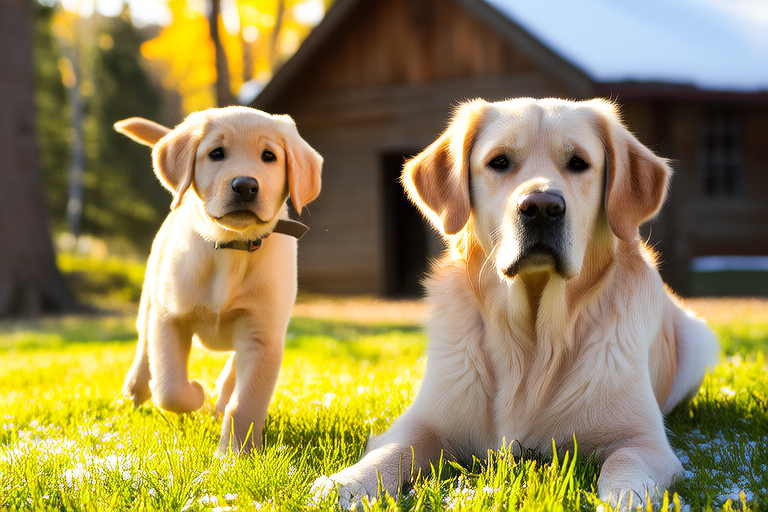From Puppies to Seniors: Captivating Moments in a Labrador’s Life
Welcome to the heartwarming journey of a Labrador’s life, from their playful puppyhood to their serene senior years. This article will take you through the distinct stages of a Labrador’s development, highlighting their unique behaviors, training milestones, health considerations, and the profound emotional bonds they form with their human companions.
Puppyhood: The Beginning of a Lifelong Adventure
The first chapter in a Labrador’s life is marked by boundless energy and an insatiable curiosity about the world. At just eight weeks old, puppies start exploring their new environment, often with wide, inquisitive eyes and tiny paws that barely touch the ground. Their early days are filled with learning basic commands like ‘sit’ and ‘stay,’ which are crucial for their future behavior.
Training during this phase is both challenging and rewarding. Labrador puppies are known for their intelligence and eagerness to please, making them quick learners. However, they also have short attention spans, so training sessions should be brief but frequent. Positive reinforcement works wonders, turning simple commands into joyful games.
Health considerations during puppyhood include vaccinations, deworming, and regular check-ups. Puppies are prone to various illnesses and parasites, so ensuring they receive proper medical care is essential. Socialization is another critical aspect; introducing your puppy to different people, animals, and environments helps them grow into well-adjusted adults.
Anecdote: One memorable moment was when my Labrador puppy, Max, encountered a flock of geese. Instead of running away, he approached them with cautious curiosity, his tail wagging tentatively. It was a heartwarming sight, showcasing the resilience and bravery inherent in these dogs.
Adolescence: The Teething Phase and Growing Pains
As Labradors enter adolescence, they experience significant physical changes. Their growth spurt brings increased energy levels and a desire to test boundaries. This period can be challenging for owners as puppies become more independent and less eager to follow commands.
Teething is another common issue during this stage. Labradors may chew on anything within reach, including furniture and shoes. Providing appropriate chew toys and redirecting their chewing habits can prevent damage to household items. Training during adolescence focuses on reinforcing obedience and correcting unwanted behaviors.
Health concerns during adolescence include hip dysplasia and joint problems, which are more prevalent in larger breeds like Labradors. Regular exercise and a balanced diet are vital to maintaining their overall health. Vet visits should continue to ensure they’re growing properly and to address any emerging health issues.
Anecdote: My Labrador, Bella, went through a particularly stubborn phase where she refused to obey basic commands. One day, I found her lying next to a chewed-up pair of slippers. Despite her disobedience, her loyalty and love were unwavering, and we bonded even stronger during this challenging time.
Adulthood: A Time of Peak Activity and Bonding
Once Labradors reach adulthood, typically around two years of age, they settle into a routine of consistent activity and companionship. They are at their most energetic and active, requiring daily exercise to maintain their physical and mental well-being. This is also the time when they fully understand and respond to commands, making them reliable and obedient companions.
Training in adulthood focuses on advanced commands and tricks, such as retrieving objects, fetching, and even agility training. Labradors excel in these activities, showcasing their natural athleticism and intelligence. They are often used as service dogs, search-and-rescue dogs, and therapy dogs due to their excellent temperament and trainability.
Health-wise, adult Labradors should maintain a healthy weight to avoid joint problems. Regular vet check-ups and dental care are necessary to keep them in top condition. Mental stimulation is equally important, as boredom can lead to destructive behavior. Interactive toys and puzzles can help keep their minds sharp.
Anecdote: My Labrador, Charlie, was an exceptional swimmer. We spent countless afternoons at the lake, where he would retrieve sticks thrown far out into the water. His joy and enthusiasm were infectious, and it was during these moments that our bond truly deepened.
Senior Years: Embracing Wisdom and Slowing Down
As Labradors reach their senior years, usually around seven years of age, they begin to slow down. Their energy levels decrease, and they may develop arthritis or other age-related conditions. Despite this, their loyalty and affection remain unwavering.
Senior Labradors benefit from gentle exercise and a diet tailored to their specific needs. Joint supplements and pain management can alleviate discomfort caused by arthritis. Regular vet visits are crucial to monitor their health and address any emerging issues promptly.
The emotional bond between a Labrador and their owner often reaches its peak during these later years. Senior dogs provide comfort and companionship, offering a sense of security and peace. They are often referred to as ‘Velcro dogs’ due to their strong attachment to their owners.
Anecdote: My Labrador, Daisy, was always by my side during her senior years. She would curl up beside me on the couch, her presence a constant reminder of the joy she brought into my life. Even though she couldn’t run as fast or play as vigorously, her love never waned.
Conclusion: A Lifetime of Love and Memories
From the playful puppyhood to the serene senior years, each stage of a Labrador’s life offers unique moments of joy and learning. Their loyalty, intelligence, and affection make them cherished members of many families. Whether they are teaching us patience, providing comfort, or simply being there to share our lives, Labradors enrich our existence in countless ways.
Embracing the entire lifecycle of a Labrador allows us to appreciate not only their physical attributes but also their emotional depth. By understanding and supporting them through every stage, we ensure that our Labradors live long, happy, and fulfilling lives. So, whether you’re a seasoned Labrador owner or considering bringing one into your family, remember that each moment spent with a Labrador is a precious gift.
